Tillers! |
|
by Steve Hagy |
|
Ladder trucks are by necessity rather long. With the compliment of ground ladders carried on a typical rig in an urban area by the late 1800’s, the size of these rigs had reached the point that it was increasingly difficult to maneuver them through the streets |
|
To assist in steering, the wheels at the rear of the ladder truck were changed to allow them to be turned. The tiller, and the tillerman, had come into existence. All of the horse drawn aerials purchased and some of the service trucks were of the tiller variety. Once motorization of the department began, tillered ladder trucks were the standard for 75 years. |
|
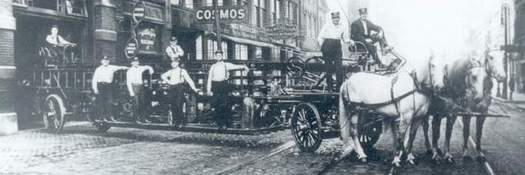 Truck 1 poses on 6th Street with their 1903 Seagrave 85’ aerial. Steve Hagy Collection |
|
Although all ladder companies today operate with an aerial, at the beginning of motorization an aerial was the exception for truck companies. City service trucks were being used by 12 of the 16 ladder companies on the roster. Each truck company carried all of the same tools and a similar ground ladder compliment, however the service trucks did not have an aerial device. |
|
The first motorized tiller on the C.F.D. was an Ahrens-Fox city service truck assigned to Truck 3 at Eastern and Strader Avenues. The new rig was housed in the recently completed bungalow style station that was also quarters for Engine 18. This house, which is still standing today, was a departure from previous stations in that it was constructed for use with motorized apparatus. |
|
 The first motorized ladder truck on the roster was this 1916 Ahrens-Fox at Truck 3. Jim Murray Collection. |
|
Loyalty to Ahrens-Fox brought about some strange combinations in 1917. Four new Ahrens-Fox tractors were ordered for ladder trucks and at the same time, 2 Seagrave service truck trailers (assigned to Trucks 7 & 9) and 2 Seagrave 85-foot aerial trailers (Trucks 1 & 2) were also purchased. This resulted in new Ahrens-Fox/Seagrave ladder trucks! |
|
 Two of these Seagrave city service ladder trailers were delivered in 1917. Notice the pompier ladders carried on the top and bottom of the rig and leather buckets hanging from the rear. Steve Hagy collection. |
|
New service trucks, aerials, and truck tractors were purchased by the C.F.D. until motorization of the department was completed during 1921. In 1923 a new Ahrens-Fox service ladder was placed in service at Truck 7. This would be the last city service truck acquired by the department. After the ‘23 Fox was removed from the Cincinnati roster, the Batesville, Indiana Fire Department operated the rig for many years. |
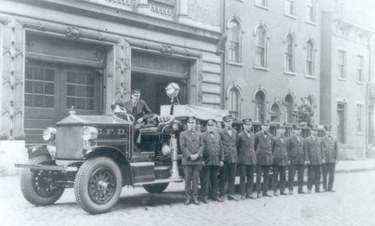 The last city service truck purchased by the C.F.D. was this 1923 Ahrens-Fox tiller assigned to Truck 7. Steve Hagy collection. |
During the late 1920’s a pair of Ahrens-Fox aerials was purchased and during the 1930’s, Mack was the preferred supplier of fire apparatus to Cincinnati. Besides many pumpers, Mack also delivered 2 tiller aerials to the department. The 1937 Mack 85 foot aerial assigned to Truck 7 was the last rig ordered using a wood stick. |
|
 Truck 7 also received the last wood aerial purchased by the department. Steve Hagy collection. |
|
In 1941, the C.F.D. purchased their first metal aerial, a 100-foot job that went in service at Truck 1. This Seagrave would be the basic design of most tillers purchased by the CFD during the next 25 years. 1946 saw a stranger among the apparatus fleet. The first motorized American LaFrance rig arrived for the department. The 600 series American LaFrance was a large, bulbous looking rig compared to the much smoother lines of the Seagrave apparatus being delivered. It was unique in that the lettering on the door was “No 5” instead of just the company number. |
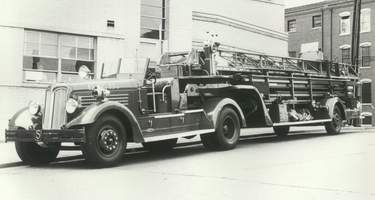 Seagrave delivered the first metal aerial on the roster in 1941. Ed Effron photo. |
Truck 3 may have been the first motorized ladder company on the roster, but they were the last ladder company to be assigned an aerial truck. In 1951 a new Seagrave 85-foot tiller was assigned to Truck 3 replacing the Ahrens-Fox service truck that had been assigned to them in 1916. 35 years of service at one company! |
|
In 1966 Cincinnati took delivery of their last open cab rig. 19 Seagrave aerials of this general design had been purchased between 1941 and 1966. Truck 5 had the honor of placing this rig in service although it was assigned to Truck 4 shortly afterward. The tractor of this piece eventually was converted for use to pull the trailer with Boat 4 aboard. In 1967, the first cab forward tractor style tillers arrived from the Seagrave plant in Clintonville, Wisconsin and were placed in service at Truck’s 1 and 6. These rigs were the first to have a fixed position tiller seat. No more having to flip the seat over in order to raise the stick! |
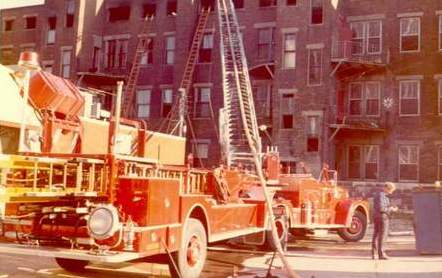 The last rig with a flip over style tiller bucket was this 1966 Seagrave, shown here at a 2nd alarm on McMillan Avenue in the spring of 1974. Steve Hagy photo. |
The second and last, American LaFrance aerial to go to work with the C.F.D. arrived in 1968. Truck 5 also was assigned this rig. The year 1972 saw the first of the 4-door cab rigs purchased and placed in service at Trucks 9, 12, and 13. These rigs finally saw the tillerman removed from the elements as they featured an enclosed tiller cab. |
|
In 1975, Trucks 3 and 14 were assigned new Seagrave 100-foot aerials, replacing the last 2 85-foot aerials in first line service. This also meant that since 1916, Truck 3 had only been assigned 2 pieces of apparatus! In 1977, the cab tractors reverted back to the 2-door styling of the pre 1972 purchases. The lone Pirsch aerial that was ever on the roster was assigned to Truck 1 in 1982 and then reassigned to Truck 16 in 1983. |
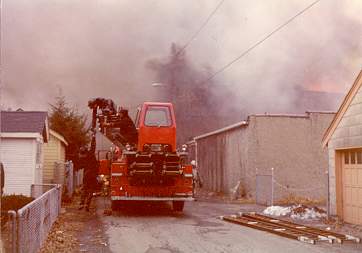 Enclosed tiller cabs were first used on the 1972 Seagrave aerials. Truck 12 is setting up a ladder pipe in the rear of Wolf Brothers furniture in Carthage. Steve Hagy photo. |
In 1992, Trucks 12 and 13 were assigned Seagrave 100-foot medium duty aerials. These workhorses would be the last tillers purchased by the C.F.D. Between 1916 and 1992, the C.F.D. operated a total of 57 tiller ladder trucks. During that 77-year period every ladder truck operated by Cincinnati would be a tiller. In 2002 the 15th rear mount Emergency One rig was delivered. Truck 3’s 1994 E-One became a spare so that the days of tillers in the Queen City will soon be over. |
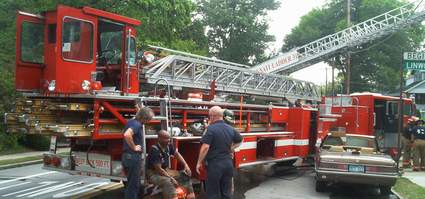 Truck 23 is seen running a spare 1992 Seagrave tiller. The 2 aerials delivered that year were the last tractor-trailers purchased by the department. Steve Hagy photo. |
 A view that will soon disappear to Cincinnati firefighters |
|